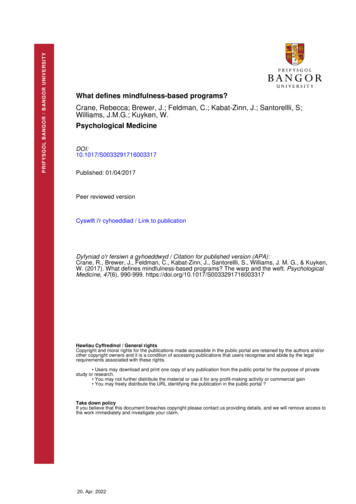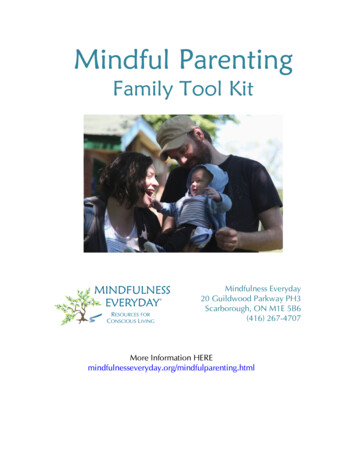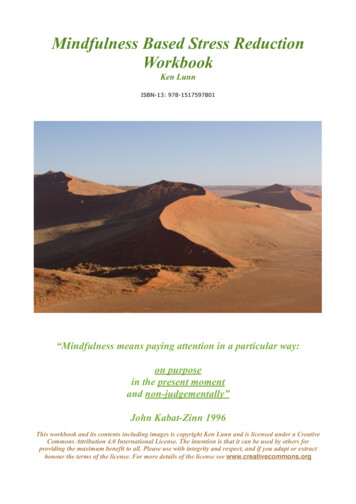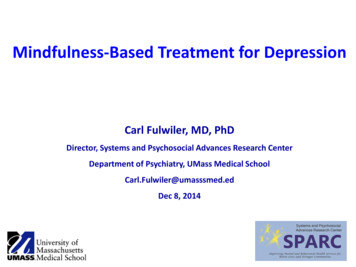
Transcription
PRIFYSGOL BANGOR / B ANGOR UNIVERSITYWhat defines mindfulness-based programs?Crane, Rebecca; Brewer, J.; Feldman, C.; Kabat-Zinn, J.; Santorellli, S;Williams, J.M.G.; Kuyken, W.Psychological MedicineDOI:10.1017/S0033291716003317Published: 01/04/2017Peer reviewed versionCyswllt i'r cyhoeddiad / Link to publicationDyfyniad o'r fersiwn a gyhoeddwyd / Citation for published version (APA):Crane, R., Brewer, J., Feldman, C., Kabat-Zinn, J., Santorellli, S., Williams, J. M. G., & Kuyken,W. (2017). What defines mindfulness-based programs? The warp and the weft. PsychologicalMedicine, 47(6), 990-999. https://doi.org/10.1017/S0033291716003317Hawliau Cyffredinol / General rightsCopyright and moral rights for the publications made accessible in the public portal are retained by the authors and/orother copyright owners and it is a condition of accessing publications that users recognise and abide by the legalrequirements associated with these rights. Users may download and print one copy of any publication from the public portal for the purpose of privatestudy or research. You may not further distribute the material or use it for any profit-making activity or commercial gain You may freely distribute the URL identifying the publication in the public portal ?Take down policyIf you believe that this document breaches copyright please contact us providing details, and we will remove access tothe work immediately and investigate your claim.20. Apr. 2022
ManuscriptWhat Defines Mindfulness-Based Programs?The warp and the weftRebecca S. Crane, Bangor UniversityJudson Brewer, University of MassachusettsChristina Feldman, Totnes, Devon, UKJon Kabat-Zinn, University of MassachusettsSaki Santorelli, University of MassachusettsJ. Mark G. Williams, University of OxfordWillem Kuyken, University of OxfordKeywords: Mindfulness-Based Program, Mindfulness-Based Stress Reduction, Mindfulness-Based CognitiveTherapy, fidelity1
There has been an explosion of interest in Mindfulness-Based Programs (MBPs) such as MindfulnessBased Stress Reduction (MBSR) and Mindfulness-Based Cognitive Therapy (MBCT) in the last two decades.MBSR has accrued a robust evidence base in improving mental health outcomes in those with chronic physicalhealth problems (Bohlmeijer, Prenger, Taal, & Cuijpers, 2010). MBCT is an adaptation developed to teachthose at high risk of depressive relapse skills to stay well and has been shown to be effective (Kuyken et al.,2016). There are multiple other MBPs with varying levels of research evidence at each stage of the researchjourney (Dimidjian & Segal, 2015).For the sustainable development of the field there is a need to pause and address some fundamentalquestions. Dimidjian and Segal (Dimidjian & Segal, 2015) analyzed the status of the extant evidence using theNational Institutes of Health (NIH) Stage Model (Onken, Carroll, Shoham, Cuthbert, & Riddle, 2014). This is amodel of behavioral intervention development composed of six stages: basic science (Stage 0), interventiongeneration, refinement, modification, and adaptation and pilot testing (Stage I); traditional efficacy testing(Stage II); efficacy testing with real-world providers (Stage III); effectiveness research (Stage IV) and;dissemination and implementation research (Stage V). The mapping of the MBP evidence base onto this modelby Dimidjian and Segal clarifies that the evidence is heavily saturated in Stage I, lightly represented in Stages 0and II, and that to date there is minimal research in stages III, IV and V. Overall, in their analysis they identifysignificant strengths (e.g. breadth of clinical problems and populations targeted), and significant weaknesses(e.g. the need for an integrated and systematic approach to core research questions across all stages of theresearch from basic through to implementation science). In this editorial we focus on a critical underpinningissue throughout the Stage Model – namely the fidelity/integrity of the intervention itself. Fidelity is central toall stages but has particular salience at Stages I and V. Stage I involves the development of the intervention,which requires great clarity about for whom it is intended, and a theoretical exposition of what mechanismsare being targeted. It also requires careful consideration of what clinician training and supervision is requiredto deliver the intervention effectively. Stage V addresses implementation, which raises similar issues aboutwhat key aspects of fidelity need to be maintained when implementing in real world settings.Given the proliferation of MBP development and research, there is a need to re-clarify the coreingredients of mindfulness-based programs, and the implications this has for professional training, supervisionand implementation. This clarity is important for the field so that existing research can be meaningfully2
interpreted, future research uses agreed definitions and established protocols, MBP teachers are trainedappropriately, and the general public are assured that programs titles accurately describe what is delivered.Mindfulness-Based Programs in ContextMBSR was developed as an education and training vehicle for people with chronic health problemsand those suffering from the mounting demands associated with psychological and emotional stress, to learnto relate in new ways to life challenges (Kabat-Zinn, 2013). Other programs based upon the foundationalapproach and structure of MBSR have since been developed with particular aims across a broad range ofsettings, including hospitals, schools and prisons, and are gaining interest from policy makers (Mindfulness AllParty Parliamentary Group, 2015; Ryan, 2013).MBP developments are nested within a wider context of empirical developments within psychology,medicine, health care and education which include ‘mindfulness-informed’ programs such as Acceptance andCommitment Therapy (Hayes, Strosahl, & Wilson, 2011), Compassion Focused Therapy (Gilbert, 2009),Dialectical Behavioral Therapy (Linehan, 1993), Mindful Self Compassion (Neff & Germer, 2013) anddevelopments in the field of Positive Psychology (Seligman & Csikszentmihalyi, 2000). These mindfulnessinformed developments are part of the third wave of empirically tested psychotherapies (first wave beingbehavioral therapy; second wave being cognitive behavioral therapy). Third wave approaches have adecreased emphasis on controlling internal experience, and an increased emphasis on themes such asacceptance, metacognition and how people relate to their experiences. Mindfulness-informed programs shareseveral underpinning theoretical ideas with MBPs, and many include some mindfulness meditation practice intheir approach. However, a distinctive feature of MBPs is that systematic and sustained training in formal andinformal mindfulness meditation practices (for both teacher and participants) is central both to thetherapeutic approach and underpinning theoretical model. They are based on mindfulness.It should also be noted that other MBPs exist alongside MBSR/MBCT which also share this emphasison the practice of mindfulness-meditation as a central pedagogical component. An important example are‘second generation ’ mindfulness-based interventions which are openly spiritual in nature, make the linkage tothe Buddhist teachings explicit within the pedagogy and are more traditional in the manner in which theyconstruct and teach mindfulness (Van Gordon, Shonin, & Griffiths, 2015).These programs are at an earlierstage of development and research is now underway. However, the boundary to the analysis in this paper are3
what have retrospectively become termed ‘first-generation’ MBPs – i.e. MBSR and MBCT (which represent thestrongest evidence within the field), and the range of programs which have developed out of these (e.g.Bowen et al., 2009; Duncan & Bardacke, 2010; Kristeller, Sheets, Wolever, & Bolinskey, 2012). These firstgeneration MBPs, whilst drawing aspects of their underpinning models and practices from aspects ofBuddhism, aim to clearly re-contextualise both the program content and theoretical underpinnings within themainstream. That is to say, the aim is to ensure MBPs are based in science and contemporary approaches tomanaging mental and physical health and supporting well-being; that they are suitable for delivery inmainstream public institutions across a range of settings and cultures; and that they are maximally accessibleto people with diverse values and religious affiliations.It is also important to note that while MBPs have been developed for particular issues such as stressand depression, there are other empirically supported approaches for such difficulties. There is as yet nocompelling evidence for specificity of hypothesized mechanisms or differential outcomes. This may be anartifact of the many shared components between these approaches, or it may simply be that this work has notyet been done. Our hope is that the clarity we aim to offer in this editorial will support measurement,mechanisms, and mediators research, as a recent editorial has argued is needed (Davidson, 2016).Development Trajectory for Mindfulness-Based ProgramsIn the context of high interest and rapid proliferation Dimidjian and Segal (2015) identify several keychallenges for the next phase of research developments. This editorial focuses on one of these challenges research and practice issues in the arena of MBP fidelity. If these challenges are not carefully addressed theywill undermine the developing science as well as the quality and integrity of implementation in routinepractice. Mindfulness training in various forms is rapidly being applied within different contexts andpopulations, and morphing into multiple curriculums of differing lengths and teaching methods. Mindfulnesscan be intuitively appealing to teachers and participants. There is consequently a grassroots spread of practiceinto populations and contexts, which at times is ahead of the evidence. The word mindfulness has become aword conveying a multitude of meanings and practices. This is a confusing context within which tosystematically build the science and the practice integrity of MBPs.The Essential and Variable Elements of First Generation MBPs4
We use the metaphor of ‘warp and weft’ to represent the ‘fabric’ of MBPs. In weaving, the warp is theterm for the fixed thread that runs vertically through the cloth, while the weft is the term for the transversethread that makes each tapestry unique. The warp is the thread that is fixed when the loom is set up, while theweft varies in texture and color. The essential, constant and integral threads that define an MBP regardless ofpopulation or context make up the ‘warp’; they are what make it a mindfulness-based program. Each adaptedMBP then introduces a unique ‘weft’ that seeks to target the training to a particular population and/orcontext. Within each aspect (program and teacher) we examine what is warp (i.e., essential to an MBP), andwhat is weft (i.e., will vary depending on context and/or population) (Table 1). The warp elements of theframework are anchored within the program forms of MBSR and MBCT. We suggest that the framework weoffer can provide some unifying clarity for the wider MBP field on what an MBP is and is not.The Essential (‘Warp’) Elements of Mindfulness-Based ProgramsThe MBP program1.Is informed by theories and practices that draw from a confluence of contemplative traditions, science,and the major disciplines of medicine, psychology and educationThe key influences that have shaped MBPs are:Contemplative mindfulness practices: MBPs are underpinned by theories about the human mind-body drawnfrom aspects of early Buddhist psychology, which articulate the ways in which people can come to recognizeuniversal habitual psychological patterns that create and maintain distress. This philosophy and psychology isnuanced and complex. It includes a wide array of teachings and practices found across the breadth of bothBuddhist and other traditions, which are beyond the scope of this paper (Williams & Kabat-Zinn, 2013).However, there is high level consensus on common features found within the cultivation of mindfulness. Theseinclude that people can learn that habitual reactive patterns stem from unhelpful habits of the mind; that fear,denial and discrepancy-based thinking create and exacerbate distress; and that skillful ways of relating toexperience can be developed through awareness, wise discernment and practice which offer the potential for(moments of) freedom from reactivity (Gethin, 1998).MBPs address some universal features of human experience using mindfulness practices as a vehiclefor a systematic training of the mind in the service of developing greater awareness of self and others, and5
thus, greater understanding. It is therefore not surprising that mindfulness practices can be found in many ofthe world’s contemplative wisdom traditions. MBPs draw on aspects of these traditions whilst leaving behindtheir religious, esoteric and mystical elements. Crucially they are presented in an invitational way, askingpeople to use the mindfulness practices in whatever way best supports their aims and aspirations. Thepractices and frameworks employed within MBPs are thus re-contextualized for implementation withinmainstream settings by ensuring that they are delivered in inclusive and culturally appropriate ways.Science: The development of MBPs is grounded in developments in theory, cognitive neuroscience (Tang,Holzel, & Posner, 2015), translational research (Meadows et al., 2014; Strauman & Merrill, 2004) andevidence-based practice across a range of disciplines. Empirical evidence informs the theoretical modelsunderpinning MBP’s aims and innovations, and continues to refine understanding of what works best, at whattime, for which group of participants (Davidson, 2016).Medicine: MBSR, the original MBP, was developed within a medical framework and culture, as a form ofparticipatory medicine in which patients are challenged to discover and draw upon their own resources forlearning, healing, and transformation (Kabat‐Zinn, 2003).Psychology: MBPs were introduced and incorporated into the field of psychology through the development ofMBCT (Segal, Williams, & Teasdale, 2013). Psychological theory and research now guides the development ofmany MBPs (Dimidjian & Segal, 2015). Indeed, the field of cognitive science has to a large extent taken overthe detailed work of investigating the precise mechanisms by which MBPs alleviate distress and enableflourishing. The process involves mapping theories and empirical understanding across a range of disciplines.Education: The pedagogical processes employed in MBPs draw on educational principles that are experiential,interactive, participatory, student–centred and relationship-centred (Santorelli, 2000).2.Is underpinned by a model of human experience which addresses the causes of human distress and thepathways to relieving it6
The confluence described in the previous section is supported by a model of distress that appliesacross MBPs that explains certain facets of how human distress is created and maintained, and howmindfulness training deals with these maintaining factors, and thus alleviates distress and supports mentalhealth and well-being e.g. (Kabat-Zinn, 2013; Segal et al., 2013). It draws on aspects of cognitive science (e.g.,attention and executive control and decentering (Barnard & Teasdale, 1991)) and trans-diagnostic work (e.g.repetitive thought and experiential avoidance (Dudley, Kuyken, & Padesky, 2011)). This emerging model isbeing clarified and developed as empirical understanding is built (e.g. Brewer, Elwafi, & Davis, 2013; Chiesa,Serretti, & Jakobsen, 2013; Gu, Strauss, Bonda, & Cavanagh, 2015; van der Velden et al., 2015). The field isyoung and emergent, and the underpinning frameworks are the subject of debate and empirical investigation.3.Develops a new relationship with experience characterized by present moment focus, decentering, andan approach orientationAn underpinning premise of the MBP model is the understanding that how people relate and respondto various forms of distress (rather than the distress itself) lies at the core of many problems and disorders. Itis this that determines both the capacity and the extent to which distress can be relieved and transformed. Thetraining aims to enable participants to recognize habitual, conditioned modes of reacting and make a radicalshift in their relationship to their thoughts, feelings and body sensations, as well as to outer circumstances. Theshift in relationship is based on what is called decentering (Segal et al., 2013) or re-perceiving (Shapiro,Carlson, Astin, & Freedman, 2006), in which the MBP participant is trained to attend to thoughts and feelingsas mental events by noticing how they come and go in the mind and how each has consequences in the verynext moment. For example, a person who is rushing to a meeting, might come to realize that in addition to thestress of being late they are compounding the stress by the thought ‘if I’m late everybody will think I am notcoping’. Whereas in an approach such as cognitive therapy, a person might be taught to challenge such athought, in MBPs the emphasis is on seeing it as a mental event, noticing its effects on the body, and the way itcreates further feelings and thoughts that were not part of the original situation. Gradually people come to seethat their thoughts are not necessarily valid representations of reality.4.Supports the development of greater attentional, emotional and behavioral self-regulation, as well aspositive qualities such as compassion, wisdom, equanimity.7
Attentional training within MBPs offers a foundation for the attitudinal dimensions of mindfulness toemerge. MBPs seek to support the ability to meet experience with curiosity, equanimity and compassion(Feldman & Kuyken, 2011). An experiential understanding develops that pain is an inherent part of humanexperience and is ever changing. An orientation of mind characterized by curiosity, patience and equanimitysupports the development of compassion and wisdom. There is an intention to cultivate an internal climate offriendliness towards experience – whether it be pleasant or unpleasant. This supports a shift away fromhabitually battling with experience. MBPs also aim to cultivate positive qualities such as joy, and the ability torecognize and savour nourishing and pleasant experiences.5.Engages the participant in a sustained intensive training in mindfulness meditation practice, in anexperiential inquiry-based learning process, and in exercises to develop insight and understanding.Direct experiential, systematic and intensive engagement in formal and informal mindfulnessmeditation practices is foundational to teaching/learning in MBPs. The training develops familiarity with andunderstanding of the mind and body, and appreciation that attention can be regulated, fine-tuned, andoptimized through training. Rather like physical training regimes, the training progresses developmentally andsequentially throughout the program.The integrity and fidelity of each MBP is maintained by ensuring that all the curriculum elements forthe particular program are included as intended (adherence) and that curriculum elements are not addedwhich do not belong to the particular program form (differentiation) (Crane et al., 2013). It is critical that thecurriculum employed and the particular MBP title match each other. If there is divergence from an establishedcurriculum, teaching structure or process then a new title for the adaptation should be employed, andresearch should clearly identify the adapted curriculum guide used and if any checks on fidelity and adherencewere employed.Adherence to program form is supported by protocols for each MBP (e.g. see Blacker, Meleo-Meyer,Kabat-Zinn, Koerbel, & Santorelli, 2015; Stahl & Goldstein, 2010, for MBSR curriculum guides, and Segal et al.,2013, for the MBCT curriculum guide). Other MBPs have published guides which specify their particularcurriculum adaptations. MBP curriculums vary in terms of number and duration of sessions and timecommitments for home practice. For example, MBSR is scheduled over eight weekly sessions lasting 2.5hourswith 45 minutes of guided mindfulness meditation home practice per day. MBCT is the same but with 2 hour8
long sessions. There is not scope to fully list the curriculum elements and therapeutic techniques which, ifincluded, would be regarded as outside the model for a particular first generation MBP (the differentiationaspect of program integrity). However, examples include: thought challenging and collecting evidence for andagainst the truth for thoughts (which is part of cognitive therapy); an orientation of problem solving or fixing;different sorts of meditation practices (e.g. mantra meditation); talking about the detailed history ofparticipants; and an emphasis on relaxation training.MBPs typically include mindfulness training via three formal mindfulness meditation practices – thebody scan, mindful movement and sitting meditation. Practices are assigned as daily home practice with thesupport of recorded guidance. Throughout the program participants are also encouraged to generalize throughinformal practice by bringing awareness in particular ways to everyday activities.MBPs include learning experiences built around the formal mindfulness meditation training. Theseinclude engaging in an individual and collective investigative inquiry to develop skills in recognizing directexperiences (i.e. thoughts, emotions and sensations), patterns of relating to experience, and the widerimplications of the understandings that emerge. This externalized teacher- led interactional process in classbecomes a representation of the work that the MBP participants begin to engage in within themselves,whereby the investigative process becomes ‘internalized’. Foci for inquiry include participants’ directexperience of meditation practices, and exploration of pleasant and unpleasant experiences which hasimplications for recognizing established patterns of reactivity and the possibility of responding differently. Thefocus will depend on the context/population, but MBPs particularly investigate the territory of difficult,unwanted experiences – stress, depression, physical pain, etc. Participants are invited to explore ‘How am Iexperiencing and relating to these difficulties physically, emotionally and psychologically? What possibilitiesare there for stepping out of habitual aversive reactive patterns into responding with greater awareness andagency?’ Each MBP employs particular exercises to facilitate these investigations.The Teacher1.Has particular competencies which enable the effective delivery of the MBPMBP teachers have particular ‘explicit’ or ‘visible’ teaching competencies. These competencies aredescribed and can be assessed using the Mindfulness-Based Interventions: Teaching Assessment Criteria(MBI:TAC), which has shown promising evidence as a reliable and valid tool (Crane et al., 2012; Crane et al.,9
2013; Crane, Soulsby, Kuyken, Williams, & Eames, 2016). The six teaching competence domains within theMBI:TAC are coverage, pacing and organization of the session curriculum; specific interpersonal relationalskills; skilful guiding of formal mindfulness meditation practices; specific methodologies for conveying thecourse themes through interactive inquiry, group dialogue and didactic teaching; and effective holding of thegroup teaching/learning environment. These require particular tailored training experiences to develop (Crane,Kuyken, Hastings, Rothwell, & Williams, 2010).2.Has the capacity to embody the qualities and attitudes of mindfulness within the process of theteachingMBP teachers have in common a sustained commitment to cultivating mindfulness through regulardaily formal and informal mindfulness practices in everyday life. The way in which mindfulness practicemanifests in the life of the teacher and is tangibly sensed in the MBP classroom is termed ‘embodiment’. Thetheoretical model hypothesising how MBP training has its effects includes embodiment as a critical factor inenabling participants to move towards experiential (rather than conceptual) knowing of mindfulness (Teasdaleet al., 2002). Embodiment is a natural outcome of the teacher’s intention to mindfully inhabit their experiencein everyday life and in the MBP classroom, to whatever degree possible in any given moment. It is neither astriving for a particular state, nor a contrivance to artificially fabricate a particular persona, mask orappearance. Through their own personal mindfulness practice, teachers naturally come to inhabit the qualitiesassociated with mindfulness (i.e. non-striving, non-judging, allowing), and the understandings and ethicsunderpinning the practices. The embodied practice element of ethics within MBPs are thus emergent andcultivated through the practice rather than being mandated. The practice of mindfulness enables theparticipant to try out the possibility of eliciting kindness, openness, and patience toward immediateexperience, whether the experience is perceived as pleasant, unpleasant, or neutral (Grossman, 2015). MBPteacher training aims to cultivate the capacity in teachers to communicate mindfulness through the process asmuch as through the content of the teaching, by integrating training in formal and informal mindfulnesspractices into the other aspects of the teacher education and training curriculum.3.Has engaged in appropriate training and commits to on-going good practice10
MBP teachers have by necessity engaged in appropriate education and training to build and deepentheir teaching competence (Crane et al., 2010; Crane et al., 2012; Kabat-Zinn et al., 2011; Marx, Strauss, &Williamson, 2015). Training involves foundational experiential engagement with mindfulness practice and withthe particular MBP curriculum the teacher training is embedded within, preliminary teacher training to buildcore skills, knowledge and attitudes, and then further training to enable the practitioner to reach the thresholdof competence. Within some training programmes, the training journey culminates in an assessment ofteaching competence using the MBI:TAC (Crane et al., 2016), conducted by trainers who have been trained toreliably use the tool.Teachers then commit to on-going good professional practice in line with consensually agreed goodpractice standards and guidelines (Evans et al., 2014; Santorelli, 2014; UK Network for Mindfulness-BasedTeacher Training Organisations, 2012). Two key elements of good practice are supervision (Evans et al., 2014),and ongoing engagement with a personal mindfulness practice including periodic periods of intensivemindfulness practice in a residential setting. As the work of first generation MBPs is becoming moreestablished in the mainstream, more opportunities are opening up for residential mindfulness intensiveswithin a thoroughly mainstream context (e.g. Mindfulness Network CIC, 2016).In the UK there is a national listing of MBP teachers who have undertaken training to minimum goodpractice level, and are adhering to ongoing good practice (UK Network for Mindfulness-Based Teacher TrainingOrganisations, 2016). In the USA there is an MBSR Registry for certified teachers (Centre for Mindfulness inMedicine Health Care and Society, 2016). The organisation of governance within this emerging field to supportthe general public to access well prepared and qualified MBP teachers is underway.MBP teachers operate within professional ethical codes anchored within their root profession (i.e.medicine, clinical psychology, teaching etc) (Baer, 2015), and appropriate to the ethos and ethics of themainstream public institution within which they are implementing (Crane, 2016).4.Is part of a participatory learning process with their students, clients or patientsDelivery of MBPs is usually in a group context which supports perspective taking and the transitionfrom personal story into investigation of common pathways which lead to distress. MBP teachers embedthemselves within this investigation. They are in a particular form of relationship with their participants which11
is underpinned by recognition of our ‘common humanity’ (shared human experience) (Neff, 2011), and thusthe mutual nature of the learning process (Santorelli, 2000).Integration of Tailored Elements into Adapted Mindfulness-Meditation Based ProgramsAs the field has developed, new MBPs have woven in a weft that aims to make the mindfulnessframework and practices more accessible and useful for particular populations and in varying contexts.However it remains an empirical question for each new adaptation whether it improves the accessibility andusefulness of MBPs, and each adaptation needs to commit to building its own evidence base.Adaptations are typically of three kinds:1.Adaptations informed by theoretical frameworks or models that are particular to a new population orsetting. For example, MBCT for recurrent depression is oriented around a cognitive model ofdepressive relapse and how mindfulness can free the mind from engrained patterns of depressiverumination (Teasdale & Chaskalson, 2011).2.Adaptations to the program that make it more accessible, acceptable and potent for a population. Forexample, Mindfulness-Based Eating Awareness Training employs mindful eating practices (Kristeller etal., 2012); mindful parenting programs use parenting activities and examples (Bogels, Lehtonen, &Restifo, 2010).3.Adaptations to the program that embed MBPs in a particular context or setting. For example, MBSR isan outpatient program that can be offered in hospital outpatient settings; mindfulness in schoolsprograms (Kuyken et al., 2013) are adapted for delivery within school curricula; and mindfulness inorganizations (Chaskalson, 201
Jon Kabat-Zinn, University of Massachusetts . Saki Santorelli, University of Massachusetts . J. Mark G. Williams, University of Oxford . Willem Kuyken, University of Oxford . Keywords: Mindfulness-Based Program, Mindfulness-Based Stress Reduction, Mindfulnes










